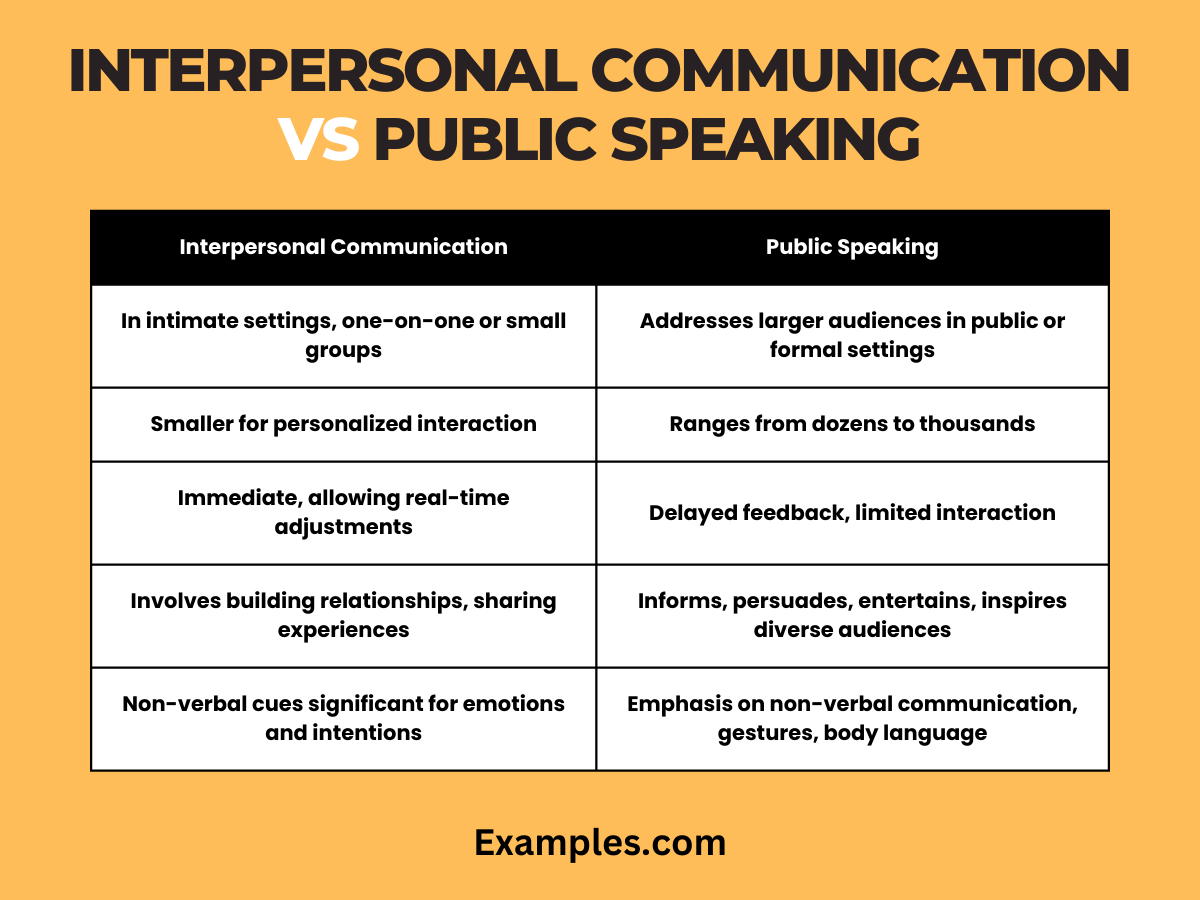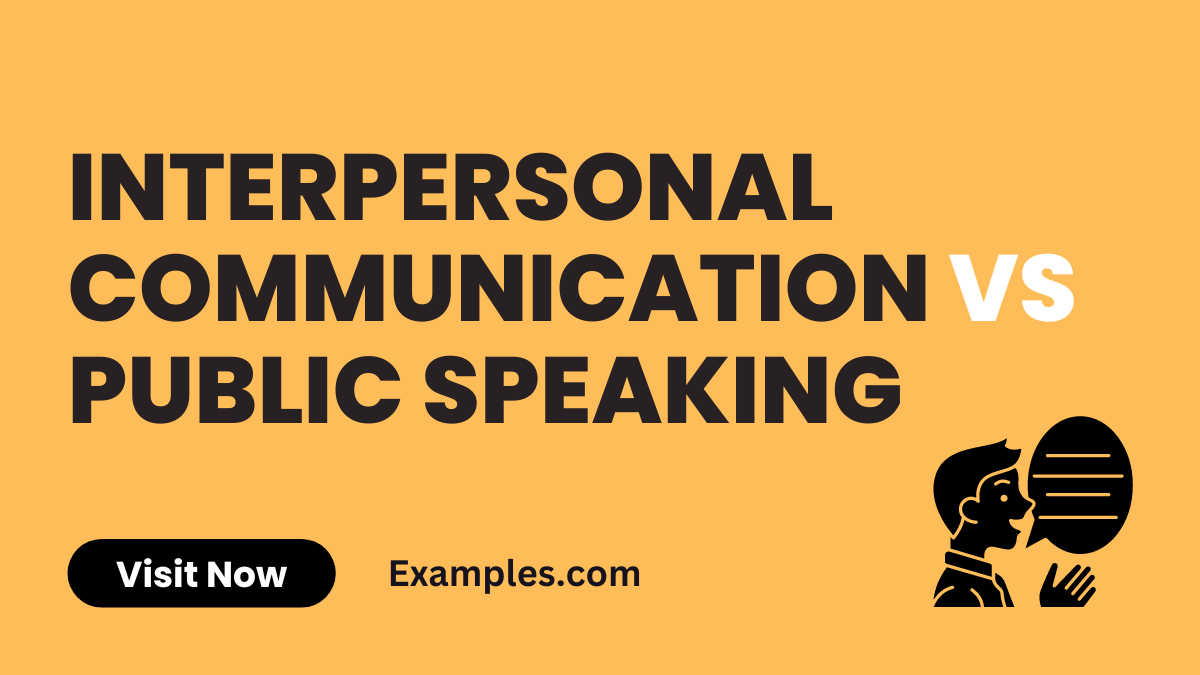Interpersonal Communication vs Public Speaking – 19+ Examples
Embark on a comprehensive journey decoding the intricacies of Interpersonal Communication vs Public Speaking. Explore how these communication dimensions differ, unveiling unique strategies and nuances. From one-on-one connections to addressing a crowd, grasp the diverse landscape with insightful examples in the realm of “Communication Examples.” Enhance your understanding of effective communication in both intimate dialogues and dynamic public addresses, navigating the distinct challenges and strengths each brings to the communication spectrum.
Difference between Interpersonal Communication and Public Speaking?

In the expansive realm of communication, distinguishing between Interpersonal Communication and Public Speaking is crucial. Explore the nuanced differences through a detailed table:
| Criteria | Interpersonal Communication | Public Speaking |
|---|---|---|
| Setting | Typically occurs in intimate settings like one-on-one or small groups. | Involves addressing larger audiences in a public or formal setting. |
| Audience Size | Smaller, allowing for personalized interaction. | Larger, ranging from dozens to thousands of individuals. |
| Feedback Dynamics | Immediate and direct, facilitating real-time adjustments. | Feedback may be delayed, and interaction with the audience is limited. |
| Purpose | Building relationships, sharing personal experiences, and resolving conflicts. | Informing, persuading, entertaining, or inspiring a diverse audience. |
| Non-Verbal Emphasis | Non-verbal cues play a significant role in conveying emotions and intentions. | Emphasis on non-verbal communication, including gestures, body language, and vocal delivery. |
| Interaction Level | High interaction, allowing for dynamic engagement and responsiveness. | Limited interaction, primarily one-way communication from speaker to audience. |
| Preparation | Less formal preparation may be required, allowing for spontaneity. | Requires extensive preparation, scripting, and rehearsal to ensure clarity and impact. |
| Example in Daily Life | Casual conversation with a friend, a job interview, or a family discussion. | Delivering a keynote speech, presenting at conferences, or addressing a community gathering. |
This comprehensive guide elucidates the distinct characteristics of Interpersonal Communication and Public Speaking, aiding a nuanced understanding of their roles in effective communication.
10 Examples of Interpersonal Communication
Embark on a journey of meaningful connection with these 10 compelling examples of Interpersonal Communication. Each instance reflects the art of effective interaction, shaping relationships and fostering understanding. Dive into real-world scenarios that showcase the power of interpersonal dynamics, from casual conversations to more profound exchanges.
- Expressing Empathy: In challenging moments, a true friend exhibits empathy, saying, “I understand your feelings; I’m here for you.”
- Active Listening: Engaging in a conversation with active listening—nodding, maintaining eye contact, and responding thoughtfully.
- Conflict Resolution: Colleagues resolve a disagreement by communicating openly, finding common ground for a resolution.
- Constructive Feedback: A mentor provides constructive feedback, emphasizing strengths and offering guidance for improvement.
- Non-Verbal Affirmation: In a relationship, partners communicate affection through non-verbal cues like smiles, hugs, and supportive gestures.
- Effective Questioning: During an interview, asking open-ended questions encourages the interviewee to share detailed responses.
- Cultural Sensitivity: In a diverse group, effective communication involves respecting and appreciating different cultural perspectives.
- Negotiation Skills: During a business negotiation, effective interpersonal communication leads to a mutually beneficial agreement.
- Expressing Gratitude: A coworker expresses gratitude, saying, “Thank you for your contributions; your efforts are truly appreciated.”
- Team Collaboration: In a collaborative project, team members communicate seamlessly, leveraging each other’s strengths for a successful outcome.
10 Examples of Public Speaking
Embark on the impactful journey of Public Speaking with these 10 exemplary instances, showcasing the art of addressing diverse audiences. From delivering powerful keynotes to engaging presentations, these examples demonstrate the essence of effective communication in larger settings, influencing and inspiring listeners.
- Keynote Address: A thought leader delivers a captivating keynote, sharing insights that resonate with the audience and leave a lasting impression.
- TED Talk: An expert delivers a TED Talk, combining storytelling and expertise to convey a compelling message in an engaging manner.
- Motivational Speech: A motivational speaker energizes the audience, using powerful language and anecdotes to inspire positive change.
- Commencement Address: At a graduation ceremony, a speaker imparts wisdom and advice to graduates, making the occasion memorable and meaningful.
- Panel Discussion Moderator: Guiding a panel discussion, a skilled moderator ensures a smooth flow of ideas, keeping the audience engaged and informed.
- Product Launch Presentation: Presenting a new product with enthusiasm and clarity, capturing the audience’s attention and generating excitement.
- Educational Seminar: In an educational setting, a speaker engages students with a seminar, making complex topics accessible and interesting.
- Political Speech: A politician delivers a persuasive speech, addressing the public with charisma and conviction to garner support.
- Conference Workshop Facilitator: Leading a workshop at a conference, a facilitator encourages participation and interactive learning among attendees.
- Town Hall Meeting: In a town hall setting, a speaker fosters open dialogue with the community, addressing concerns and building connections.
Comparison between Interpersonal Communication and Public Speaking
Embark on a detailed exploration of the differences between Interpersonal Communication and Public Speaking in this comprehensive point-by-point guide:
1. Scope of Interaction:
- Interpersonal Communication: Involves direct interaction between two individuals, fostering personal connections.
- Public Speaking: Extends to a larger audience, involving one speaker addressing a group, emphasizing one-way communication.
2. Nature of Connection:
- Interpersonal Communication: Emphasizes personal, intimate connections on an individual level.
- Public Speaking: Focuses on conveying a message to a group, with limited direct personal connections during the speech.
3. Communication Dynamics:
- Interpersonal Communication: Characterized by a more personal, two-way dynamic, allowing for in-depth exchanges.
- Public Speaking: Involves a one-way dynamic, where the speaker addresses the audience without immediate interactive feedback.
4. Adaptability to Participants:
- Interpersonal Communication: Adapts to the unique needs and preferences of two individuals, focusing on personal connections.
- Public Speaking: Requires adaptability to cater to the collective needs and interests of a larger audience, involving a more generalized approach.
5. Communication Channels and Setting:
- Interpersonal Communication: Utilizes various channels such as face-to-face interactions, calls, and personalized messages.
- Public Speaking: Primarily involves verbal communication, often in a formal setting like a conference, seminar, or public event.
6. Examples in Daily Life:
- Interpersonal Communication: Everyday conversations with friends, family, and colleagues, emphasizing personal bonds.
- Public Speaking: Examples include keynote addresses, lectures, orations, and speeches delivered to a larger audience.
7. Communication Objectives:
- Interpersonal Communication: Primarily focused on building individual relationships, sharing emotions, and resolving conflicts on a personal level.
- Public Speaking: Aims to inform, persuade, entertain, or inspire a larger audience, with an emphasis on delivering a compelling and memorable message.
8. Role of Non-Verbal Cues:
- Interpersonal Communication: Non-verbal cues like body language and facial expressions play a significant role in conveying emotions and messages.
- Public Speaking: While non-verbal cues are still present, they may be limited compared to interpersonal communication, with a greater emphasis on vocal delivery, gestures, and stage presence.
9. Impact on Social Dynamics:
- Interpersonal Communication: Shapes personal relationships on an individual level, contributing to intimate connections.
- Public Speaking: Influences social dynamics by addressing a broader audience, potentially shaping opinions, attitudes, and collective perspectives.
10. Feedback and Interaction:
- Interpersonal Communication: Involves immediate feedback and interaction, allowing for real-time adjustments based on verbal and non-verbal cues.
- Public Speaking: Feedback may be delayed, limited, or absent during the speech, with interaction often occurring in the form of Q&A sessions or discussions after the presentation.
By understanding these key distinctions, individuals can navigate the unique dynamics of both interpersonal communication and public speaking, honing skills that cater to both personal connections and effective communication with larger audiences.
Relationship between Interpersonal Communication and Public Speaking
Explore the intricate relationship between Interpersonal Communication and Public Speaking through this detailed point-by-point guide:
1. Dynamic Interaction Scope:
- Interpersonal Communication: Direct exchange between two individuals, emphasizing personal connections and immediate responsiveness.
- Public Speaking: Extends to a larger audience, involving a single speaker addressing a group, with limited immediate interactive feedback.
2. Nature of Connection:
- Interpersonal Communication: Centers on building personal, intimate connections, emphasizing the depth of individual relationships.
- Public Speaking: Prioritizes conveying a message to a collective audience, where personal connections are more generalized and indirect.
3. Interaction Dynamics:
- Interpersonal Communication: Characterized by a more personal, two-way dynamic, allowing for in-depth exchanges and mutual understanding.
- Public Speaking: Involves a one-way dynamic, where the speaker communicates to the audience without the same level of immediate interaction.
4. Adaptability to Participants’ Needs:
- Interpersonal Communication: Adapts to the unique needs and preferences of two individuals, tailoring communication styles to personal connections.
- Public Speaking: Requires adaptability to cater to the collective needs and interests of a larger audience, involving a more generalized approach.
5. Communication Channels and Setting:
- Interpersonal Communication: Utilizes various channels such as face-to-face interactions, calls, and personalized messages in diverse settings.
- Public Speaking: Primarily involves verbal communication, often in formal settings like conferences, seminars, or public events with a structured stage presence.
6. Examples in Daily Life:
- Interpersonal Communication: Everyday conversations with friends, family, and colleagues, emphasizing personal bonds and shared experiences.
- Public Speaking: Examples include keynote addresses, lectures, orations, and speeches delivered to a larger audience, where the focus is on conveying information or inspiring the collective.
7. Communication Objectives and Impact:
- Interpersonal Communication: Primarily focused on building individual relationships, sharing emotions, and resolving conflicts on a personal level.
- Public Speaking: Aims to inform, persuade, entertain, or inspire a larger audience, with the potential to influence opinions, attitudes, and collective perspectives on a broader scale.
8. Role of Non-Verbal Cues:
- Interpersonal Communication: Non-verbal cues like body language and facial expressions play a significant role in conveying emotions and messages in close, personal interactions.
- Public Speaking: While non-verbal cues are still present, they may be more focused on vocal delivery, gestures, and overall stage presence, with a greater emphasis on projecting to a larger audience.
9. Impact on Social Dynamics:
- Interpersonal Communication: Shapes personal relationships individually, contributing to intimate connections and influencing individual social dynamics.
- Public Speaking: Influences social dynamics by addressing a broader audience, potentially shaping collective opinions, attitudes, and perspectives on a larger scale.
10. Feedback Dynamics and Interaction Flow:
- Interpersonal Communication: Involves immediate and dynamic feedback, allowing for real-time adjustments based on verbal and non-verbal cues.
- Public Speaking: Feedback may be delayed, limited, or absent during the speech, with interaction often occurring through structured Q&A sessions or discussions post-presentation.
Understanding the intricate interplay between interpersonal communication and public speaking equips individuals to navigate diverse social contexts, recognizing the nuanced dynamics within each communicative domain.



